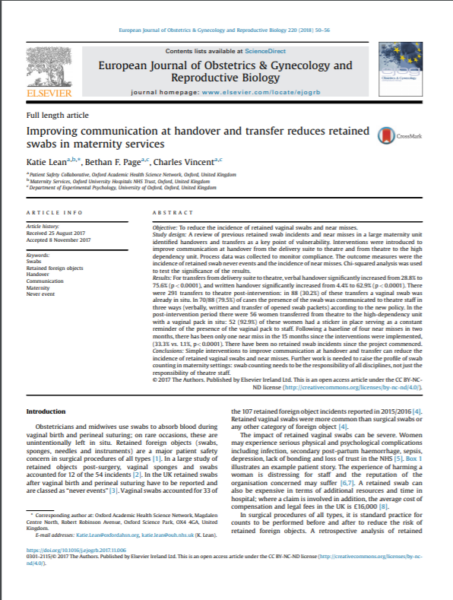 Never events are serious, largely preventable patient safety incidents that should not occur if the available preventative measures have been implemented. This quality involvement project developed robust measures to help ensure that swabs are never unintentionally left behind (retained) after procedures in maternity. This could include during caesarean delivery or when suturing is needed after a birth. Retained swabs can lead to fever, infection, pain, significant blood loss and trauma for the woman.
Never events are serious, largely preventable patient safety incidents that should not occur if the available preventative measures have been implemented. This quality involvement project developed robust measures to help ensure that swabs are never unintentionally left behind (retained) after procedures in maternity. This could include during caesarean delivery or when suturing is needed after a birth. Retained swabs can lead to fever, infection, pain, significant blood loss and trauma for the woman.
Following a baseline of four ‘near misses’ of a retained swab, there has been only one near miss in the 15 months the project has been implemented, and no cases of a retained swab.
This shows that simple interventions to improve communication at handover and transfer can have an impact on reducing the incidence of retained swab ‘Never Events’. This work has now been published in the European Journal of Obstetrics and Gynecology and Reproductive Biology.
Programme details
A reliable handover of swabs from delivery suite to theatres when women are transferred for a manual removal of placenta, suturing or examination under anaesthetic began in February 2016.
The project employed Institute for Health Improvement (IHI) methodology to test interventions directed towards standardising the following processes:
- swab counts at birth
- handover of swabs from delivery suite to theatres
- known swabs left in-situ from theatres to observation area/delivery suite
- swab counts at suturing
- documentation of swab counts
The first test of change commenced on 1 February 2016 focusing on standardising the process of handover of swabs from delivery suite to theatres – introducing a bag into the birthing packs which swabs are put in if transferred to theatre
- Reducing Never Events of Retained Swabs – driver diagram
- SPC Chart 1 – noting the adherence of 3 aspects of the swab policy when transferring a woman from delivery suite to theatre with a swab in situ including a verbal and written handover
- SPC Chart 2 – noting the verbal handover of swab count to theatre staff
- SPC Chart 3 – noting the written handover of swab count to theatre staff
- SPC Chart 4 – noting the days between near miss events (a near miss event is where there is no verbal or written handover of a swab that is in situ upon transfer to theatre and is noted by theatre staff)
The second test of change commenced on 5 December 2016 focusing on standardising the process of handover of intentional vaginal packs from delivery suite to observation area – introducing a sticker on the woman’s hand to denote this.
The following SPC charts demonstrate that a verbal handover is taking place and that a VP sticker is on the woman’s hand at transfer.
- SPC chart 5 – noting the verbal handover of an intentional vaginal pack in situ
- SPC chart 6 – noting the % of women transferred with an intentional vaginal pack in situ who had a “VP” sticker on their hand
A percentage of women have been interviewed about how they felt regarding having the sticker in place. 90% knew what the sticker was there for and felt reassured by its presence.

